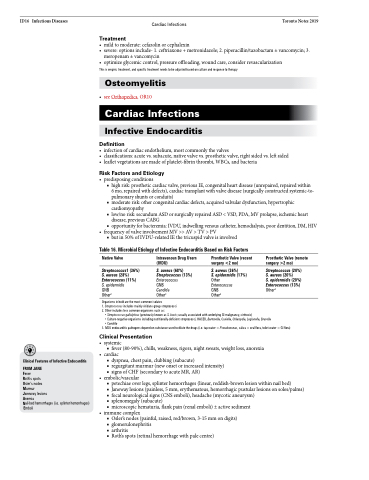Page 616 - TNFlipTest
P. 616
ID16 Infectious Diseases
Cardiac Infections Toronto Notes 2019
Treatment
• mildtomoderate:cefazolinorcephalexin
• severe:optionsinclude-1.ceftriaxone+metronidazole;2.piperacillin/tazobactam±vancomycin;3.
meropenam ± vancomycin
• optimizeglycemiccontrol,pressureoffloading,woundcare,considerrevascularization This is empiric treatment, and specific treatment needs to be adjusted based on culture and response to therapy
Osteomyelitis
• seeOrthopedics,OR10
Cardiac Infections
Infective Endocarditis
Definition
• infectionofcardiacendothelium,mostcommonlythevalves
• classifications:acutevs.subacute,nativevalvevs.prostheticvalve,rightsidedvs.leftsided • leafletvegetationsaremadeofplatelet-fibrinthrombi,WBCs,andbacteria
Risk Factors and Etiology
• predisposingconditions
■ highrisk:prostheticcardiacvalve,previousIE,congenitalheartdisease(unrepaired,repairedwithin
6 mo, repaired with defects), cardiac transplant with valve disease (surgically constructed systemic-to-
pulmonary shunts or conduits)
■ moderaterisk:othercongenitalcardiacdefects,acquiredvalvulardysfunction,hypertrophic
cardiomyopathy
■ low/norisk:secundumASDorsurgicallyrepairedASD<VSD,PDA,MVprolapse,ischemicheart
disease, previous CABG
■ opportunityforbacteremia:IVDU,indwellingvenouscatheter,hemodialysis,poordentition,DM,HIV
• frequencyofvalveinvolvementMV>>AV>TV>PV
■ but in 50% of IVDU-related IE the tricuspid valve is involved
Table 16. Microbial Etiology of Infective Endocarditis Based on Risk Factors
Native Valve
Streptococcus1 (36%) S. aureus (28%) Enterococcus (11%) S. epidermidis
GNB Other2
Intravenous Drug Users (IVDU)
S. aureus (68%) Streptococcus (13%) Enterococcus
GNB
Candida
Other3
Prosthetic Valve (recent surgery <2 mo)
S. aureus (36%)
S. epidermidis (17%) Other
Enterococcus
GNB
Other2
Prosthetic Valve (remote surgery >2 mo)
Streptococcus (20%) S. aureus (20%)
S. epidermidis (20%) Enterococcus (13%) Other2
Clinical Features of Infective Endocarditis
FROM JANE Fever
Roth’s spots Osler’s nodes Murmur Janeway lesions Anemia
Nail-bed hemorrhages (i.e. splinter hemorrhages) Emboli
• Streptococcus gallolyticus (previously known as S. bovis; usually associated with underlying GI malignancy, cirrhosis)
• Culture-negative organisms including nutritionally-deficient streptococci, HACEK, Bartonella, Coxiella, Chlamydia, Legionella, Brucella • Candida
3. IVDU endocarditis pathogens depend on substance used to dilute the drugs (i.e. tap water = Pseudomonas, saliva = oral flora, toilet water = GI flora)
Clinical Presentation
• systemic
■ fever (80-90%), chills, weakness, rigors, night sweats, weight loss, anorexia
• cardiac
■ dyspnea, chest pain, clubbing (subacute)
■ regurgitant murmur (new onset or increased intensity) ■ signs of CHF (secondary to acute MR, AR)
• embolic/vascular
■ petechiae over legs, splinter hemorrhages (linear, reddish-brown lesion within nail bed)
■ Janeway lesions (painless, 5 mm, erythematous, hemorrhagic pustular lesions on soles/palms) ■ focal neurological signs (CNS emboli), headache (mycotic aneurysm)
■ splenomegaly (subacute)
■ microscopic hematuria, flank pain (renal emboli) ± active sediment
• immunecomplex
■ Osler’s nodes (painful, raised, red/brown, 3-15 mm on digits) ■ glomerulonephritis
■ arthritis
■ Roth’s spots (retinal hemorrhage with pale centre)
Organisms in bold are the most common isolates
1. Streptococcus includes mainly viridans group streptococci 2. Other includes less common organisms such as:


